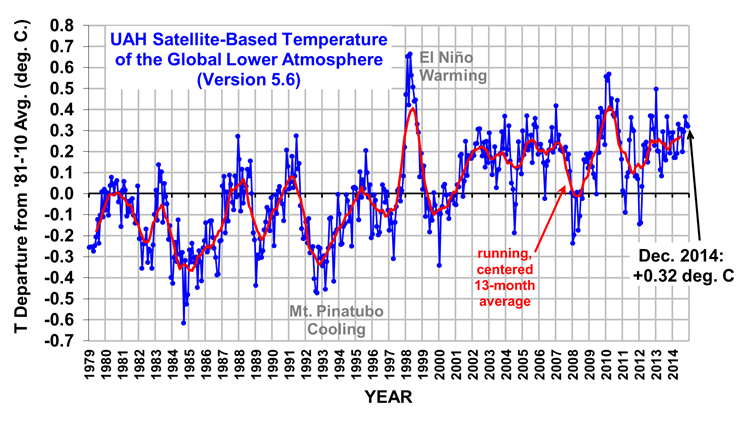2014 was Third Warmest Year Since 1979, but Just Barely
(with input from John Christy and Phil Gentry)
The Version 5.6 global average lower tropospheric temperature (LT) anomaly for December, 2014 is +0.32 deg. C, essentially the same as the November value of +0.33 deg. C (click for full size version):

The global, hemispheric, and tropical LT anomalies from the 30-year (1981-2010) average for the last 12 months are:
YR MON GLOBAL NH SH TROPICS
2014 1 +0.291 +0.387 +0.194 -0.029
2014 2 +0.170 +0.320 +0.020 -0.103
2014 3 +0.170 +0.338 +0.002 -0.001
2014 4 +0.190 +0.358 +0.022 +0.092
2014 5 +0.326 +0.325 +0.328 +0.175
2014 6 +0.305 +0.315 +0.295 +0.510
2014 7 +0.304 +0.289 +0.319 +0.451
2014 8 +0.199 +0.244 +0.153 +0.061
2014 9 +0.294 +0.187 +0.401 +0.181
2014 10 +0.365 +0.333 +0.396 +0.189
2014 11 +0.329 +0.354 +0.303 +0.247
2014 12 +0.320 +0.464 +0.177 +0.298
Notes on data released Jan. 6, 2015:
2014 was the third warmest year in the 36-year global satellite temperature record, but by such a small margin (0.01 C) as to be statistically similar to other recent years, according to Dr. John Christy, a professor of atmospheric science and director of the Earth System Science Center at The University of Alabama in Huntsville. “2014 was warm, but not special. The 0.01 C difference between 2014 and 2005, or the 0.02 difference with 2013 are not statistically different from zero. That might not be a very satisfying conclusion, but it is at least accurate.”
The 2014 average temperature anomaly is also in keeping with temperatures since late 2001, when the global average temperature rose to a level that is generally warmer than the 30-year baseline average. The most recent 13 complete calendar years, from 2002 through 2014, have averaged 0.18 C (about 0.33 degrees Fahrenheit) warmer than the 30-year baseline average, while the global temperature trend during that span was a warming trend at the rate of +0.05 C per decade — which is also statistically insignificant.
Compared to seasonal norms, the coldest annual average temperature on Earth throughout 2014 was just south of Wilmar, Minnesota. The average 2014 temperature there was –1.27 C (about 2.29 degrees F) colder than normal. The ‘warmest’ place throughout 2014 was just south of the North Pole along the International Date Line. Temperatures there averaged 1.65 C (about 2.97 degrees F) warmer than normal for the year.
Annual Global Temperature Anomalies, ranked
1. 1998 0.42
2. 2010 0.40
3. 2014 0.27
4. 2005 0.26
5. 2013 0.24
6. 2002 0.22
7. 2009 0.21
8. 2007 0.20
9. 2003 0.19
10. 2006 0.19
11. 2012 0.17
12. 2011 0.13
13. 2004 0.11
14. 2001 0.11
15. 1991 0.02
16. 1987 0.01
17. 1995 0.01
18. 1988 0.01
19. 1980 -0.01
20. 2008 -0.01
21. 1990 -0.02
22. 1981 -0.05
23. 1997 -0.05
24. 1999 -0.06
25. 1983 -0.06
26. 2000 -0.06
27. 1996 -0.08
28. 1994 -0.11
29. 1979 -0.17
30. 1989 -0.21
31. 1986 -0.24
32. 1993 -0.25
33. 1982 -0.25
34. 1992 -0.29
36. 1985 -0.31
37. 1984 -0.35
With a global average temperature that was 0.32 C (about 0.58 degrees Fahrenheit) warmer than seasonal norms, December 2014 trailed only December 2003, which averaged 0.37 C (about 0.67 degrees Fahrenheit) warmer than seasonal norms, among the warmest Decembers in the satellite temperature record. While December 2014 ranked second warmest for both the globe and the Northern Hemisphere, it was only the sixth warmest December in the tropics despite an El Niño Pacific Ocean warming event that seems to be forming there.
Warmest Decembers (1979-2014)
(Global average, warmer than seasonal norms)
1. 2003 +0.37 C
2. 2014 +0.32 C
3. 1987 +0.27 C
2013 +0.27 C
5. 2009 +0.24 C
6. 2012 +0.23 C
7. 1997 +0.22 C
2006 +0.22 C
9. 1998 +0.19 C
2005 +0.19 C
Compared to seasonal norms, the coldest place in Earth’s atmosphere in December was in northwestern Greenland, where temperatures were as much as 2.70 C (about 4.86 degrees Fahrenheit) colder than seasonal norms. Compared to seasonal norms, the warmest departure from average in December was in central Russia, north of the town of Yeniseysk. Temperatures there were as much as 2.75 C (about 4.86 degrees Fahrenheit) warmer than seasonal norms.
The global image for December should be available in the next day or so here.
Popular monthly data files (these might take a few days to update):
uahncdc_lt_5.6.txt (Lower Troposphere)
uahncdc_mt_5.6.txt (Mid-Troposphere)
uahncdc_ls_5.6.txt (Lower Stratosphere)

 Home/Blog
Home/Blog



